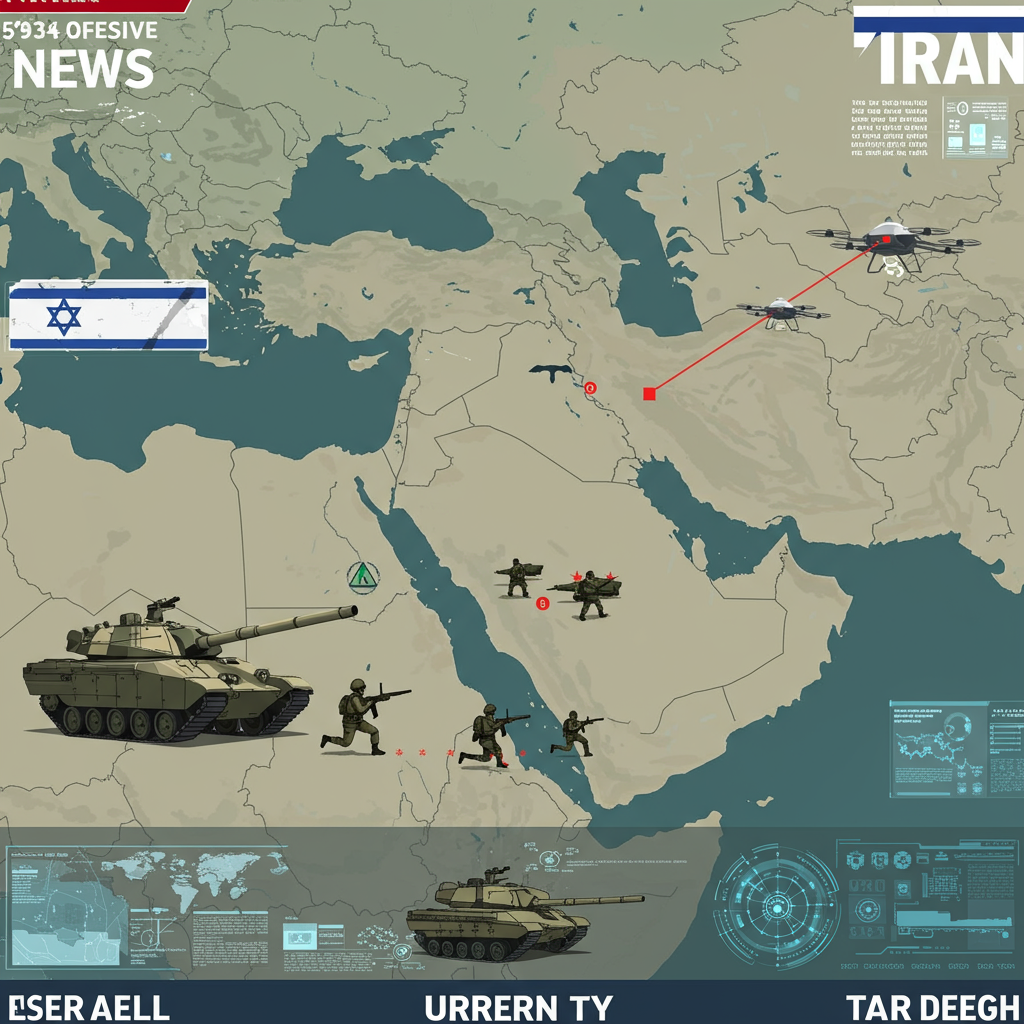Middle East Military Balance: Israel vs. Iran
On paper, a nation of nine million people taking on a regional giant of 88 million might seem like a stark mismatch. Yet, the ongoing conflict between Israel and Iran reveals a more complex military dynamic. Israel possesses a formidable and technologically sophisticated military, largely equipped by the United States, which has enabled it to achieve significant objectives against a much larger adversary.
The conflict, unfolding across the region, pits Israel’s advanced capabilities against Iran’s considerable scale and strategic depth. Examining the military balance highlights key areas where Israel holds the advantage, where Iran retains potent threats, and the broader risks of escalation.
Israel’s Decisive Military Edge
Israel’s campaign has demonstrated a significant military edge, particularly in the air. Reports indicate Israel quickly gained control of the skies over Tehran, highlighting a stark disparity in air power. Iran’s older, limited fleet of fighter jets has shown little ability to challenge modern, US-made aircraft like Israel’s F-35s.
These sophisticated jets allow Israeli forces to deliver guided munitions from relatively short ranges with minimal risk from traditional air defenses. This air superiority wasn’t accidental; earlier strikes specifically targeted and degraded Iran’s surface-to-air missile systems, including S300 batteries, using longer-range “stand-off” weapons. More recent operations have continued to hit ground-based radar and missile launchers.
Beyond airpower, Israeli intelligence operations have played a crucial role. Operatives reportedly infiltrated Iran before the main attacks, using smuggled drones to disrupt remaining air defense systems. Furthermore, Israeli strikes are said to have targeted and eliminated high-level Iranian commanders, undermining the adversary’s response capabilities.
Iran’s Enduring Threats and Capabilities
Despite Israeli successes, Iran retains considerable military power, particularly in its extensive ballistic missile arsenal. The United States has estimated Iran possesses the largest such stockpile in the Middle East, potentially numbering between 2,000 and 3,000 missiles. While Israel has targeted missile production facilities and launchers – claiming to have destroyed about a third of Iran’s surface-to-surface launchers – Iran has still been able to launch waves of missiles towards Israel. Some of these have successfully penetrated Israel’s sophisticated air defenses, including components of the Iron Dome system.
While Israel may claim air superiority over Tehran, military analysts suggest it has not achieved complete air dominance, and the threat from Iran’s short-range air defense missiles persists. Iran’s missile program remains the most significant direct threat to Israel’s security.
Strikes Inside Iran: Targets and Impact
The Israeli campaign has struck numerous strategic targets across Iran. Satellite imagery analysis provides concrete evidence of the impact, showing damage at key military and energy sites. Targets have reportedly included:
Missile Facilities: Damage has been observed at Islamic Revolutionary Guard Corps (IRGC) missile bases, including one near Kermanshah with hits on buildings and tunnel entrances potentially housing ballistic missiles. Another facility near Tehran, believed to store vehicle-launched ballistic missiles, also showed signs of precision strikes.
Infrastructure: The international airport in Tabriz showed a large blackened area on its main runway and damage to taxiways, a classic method to disable air operations.
- Energy Sites: Israeli strikes have also hit critical energy infrastructure, including a major refinery and a fuel distribution hub in Tehran, visible through large plumes of smoke captured in satellite images.
- www.bbc.com
- ca.news.yahoo.com
- www.bbc.com
- www.bbc.com
- www.bbc.com
The air campaign has also targeted strategic communication nodes. This included strikes on a state media building in Tehran. While Israel stated it targeted military-linked assets operating under civilian cover, Iran condemned the strike as a “war crime,” reporting casualties, including among civilians.
Life Under Fire in Tehran
For ordinary Iranians, the conflict has brought an atmosphere of fear, confusion, and helplessness. Residents in Tehran have described sleepless nights filled with the sound of explosions from both incoming strikes and Iranian air defenses. Visible panic set in, with long queues forming for necessities like petrol and bread, and many families attempting to flee the capital, particularly heading north.
The strikes have heightened a sense of vulnerability, especially given the reported lack of official warnings or widely accessible public shelters, a stark contrast to Israel’s preparedness. Distrust in government information is high, and residents are constantly checking news and contacting loved ones in affected areas.
The situation has also created deep divisions within Iranian society. While some expressed initial satisfaction at seeing symbols of the regime targeted, this quickly turned to sorrow and anger upon reports of civilian casualties and damage to national infrastructure. Many Iranians, even those opposed to the ruling clerical government, find the idea of freedom or human rights arriving via foreign bombs “inexcusable.” The prevailing sentiment is one of fear for the future of their country, prompting many to prepare emergency bags.
Regional Implications and Escalation Risks
Iran has cultivated a network of regional allies, notably Hamas in Gaza and Hezbollah in Lebanon, providing them with military advice, weapons, and technology. However, Israeli actions over the past two years have significantly diminished the immediate threat these groups pose from Israel’s borders. Hamas has been severely degraded in Gaza, and Hezbollah’s response capability appears reduced. The Houthis in Yemen, though geographically distant, have continued to launch occasional missile salvos towards Israel and have demonstrated resilience against US military action.
The conflict carries substantial risks of widening further. Iran has the capacity, via allied militant groups in Iraq, to target Western military bases and interests in the region. This threat has prompted Western forces, including US and UK personnel stationed in Iraq and Bahrain, to enhance preparedness. The deployment of additional RAF jets to Cyprus, for instance, reflects concerns for the safety of personnel. Furthermore, Iran retains the ability to disrupt global shipping by threatening the vital Strait of Hormuz. While widening the conflict may not currently seem strategically advantageous for Tehran, it remains a potential avenue for escalation.
Limitations and Dependence on US Support
Despite its technological advantages and initial successes, Israel’s military campaign remains heavily reliant on continued backing from the United States. Israel receives billions of dollars in US military aid annually, and much of the advanced weaponry, including munitions fired from its jets and even interceptor missiles for the Iron Dome, is US-supplied. Specialized weapons like “bunker busting” bombs used to target Iran’s underground nuclear program are also primarily sourced from the US.
However, this dependence also places limits on Israel’s actions. Reports suggest US President Trump has supported the use of bunker busters but vetoed more drastic measures, such as targeting Iran’s Supreme Leader. Moreover, the US has reportedly not granted Israel access to the Massive Ordnance Penetrator (MOP), a massive bomb potentially needed to penetrate deeply buried sites like the Fordow nuclear complex, which requires specialized US B2 bombers for delivery.
Even with significant US support, air power alone has limitations. While air strikes can set back elements of Iran’s nuclear and missile programs, they are unlikely to achieve their complete destruction or lead to regime change in Tehran. Historical examples, such as conflicts in Libya or ongoing operations in Gaza, suggest that air campaigns, while capable of creating fear and destruction, rarely result in clear-cut or decisive victories.
The conflict remains volatile, with Israel holding a technological edge and achieving significant tactical gains, while Iran retains substantial missile capabilities and regional influence, set against a backdrop of civilian impact and geopolitical risks.



